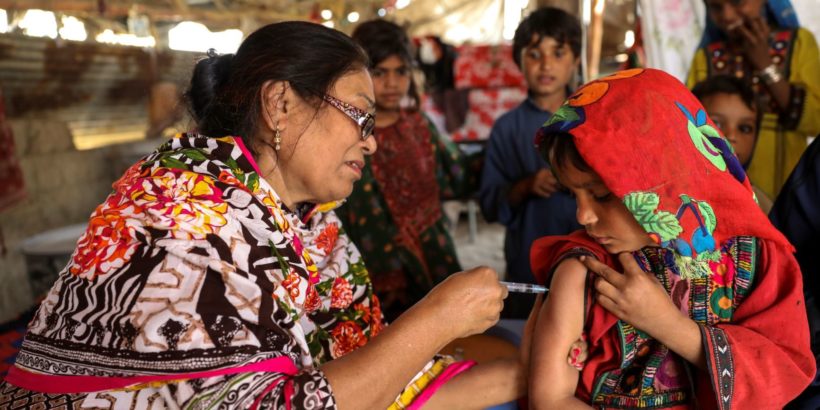Over the last six months COVID-19 has radically transformed the world. Economies have been jolted, daily life has transformed, research priorities have shifted. The far-reaching impacts of this latest pandemic have highlighted the need and importance of global, collective action to address the most significant public health challenges of our time.
This need is familiar to those working in typhoid prevention and control. While a long overlooked disease that disproportionately affects those in resource-limited settings, over the last decade we have witnessed remarkable progress in the global fight against typhoid and other invasive salmonelloses, including paratyphoid fever and invasive nontyphoidal Salmonella (iNTS) disease.
In March 2019, the Coalition against Typhoid at Sabin Vaccine Institute convened the 11th International Conference on Typhoid and Other Invasive Salmonelloses in Hanoi, Vietnam. The conference theme, “Global Action to Local Impact,” was a reflection of the need to translate the recent advances in global coordination, policy and action for typhoid prevention and control into tangible impact in endemic and vulnerable communities. Under this framing, the conversation in Hanoi was robust and focused on key topics such as rising rates of drug resistance, better understanding the burden of paratyphoid and iNTS disease, and the introduction of new typhoid conjugate vaccine (TCV).
These topics and more are highlighted in the now available special journal supplement of Clinical Infectious Diseases, “Global action to local impact: Research and developments on typhoid and other invasive salmonelloses.” The supplement—the Coalition’s most robust and comprehensive to date—features 20 articles focused on major topics discussed at the conference, including renewed and concerted efforts to develop new diagnostics; the applications of environmental surveillance for enteric disease research; addressing the worrisome rise of drug resistance; understanding the burden of typhoid, paratyphoid and iNTS disease; the vaccine development pipeline; and the impact of new TCVs and other interventions on future typhoid prevention and control efforts.
The work and research described in these articles both demonstrate the extraordinary advances that continue to be made in the fight to take on typhoid, but also the work which is still needed to realize a future free of typhoid, paratyphoid, and iNTS disease. As the global public health community rallies around the COVID-19 response, facing new challenges and an altered post-COVID research landscape, it is important that we not lose sight of this. We must continue to build on these recent successes, and use them to catalyze us to greater progress and innovation over the next two years.
Featured articles
Global Action for Local Impact: The 11th International Conference on Typhoid and Other Invasive Salmonelloses
N Duff, AD Steele, D Garrett
The Current Status of Enteric Fever Diagnostics and Implications for Disease Control
S Baker, CJ Blohmke, M Maes, PI Johnston, TC Darton
Environmental Surveillance as a Tool for Identifying High-risk Settings for Typhoid Transmission
JR Andrews, AT Yu, S Saha, J Shakya, K Aiemjoy, L Horng, et al.
Review of Methods Suitable for Environmental Surveillance of Salmonella Typhi and Paratyphi
G Matrajt, L Lilis, JS Meschke
Rapid Detection Methods for Bacterial Pathogens in Ambient Waters at the Point of Sample Collection: A Brief Review
J Li, Y Zhu, X Wu, MR Hoffmann
Antimicrobial Resistance in Typhoidal Salmonella: Around the World in 3 Days
S Saha, MSI Sajib, D Garrett, FN Qamar
Intestinal Perforations Associated With a High Mortality and Frequent Complications During an Epidemic of Multidrug-resistant Typhoid Fever in Blantyre, Malawi
F Olgemoeller, JJ Waluza, D Zeka, JS Gauld, PJ Diggle, et al.
The Surveillance for Enteric Fever in Asia Project (SEAP), Severe Typhoid Surveillance in Africa (SETA), Surveillance of Enteric Fever in India (SEFI), and Strategic Typhoid Alliance Across Africa and Asia (STRATAA) Population-based Enteric Fever Studies: A Review of Methodological Similarities and Differences
ME Carey, WR MacWright, J Im, JE Meiring, MM Gibani, et al.
Methodological Considerations for Cost of Illness Studies of Enteric Fever
N Mejia, E Ramani, SW Pallas, D Song, T Abimbola, et al.
Tenacious Endemic Typhoid Fever in Samoa
MJ Sikorski, SN Desai, S Tupua, TR Thomsen, J Han, et al.
Research on Invasive Nontyphoidal Salmonella Disease and Development Towards Better Understanding of Epidemiology, Management, and Control Strategies
S Kariuki, E Owusu-Dabo
Surveillance for Invasive Salmonella Disease in Bamako, Mali, From 2002 to 2018
WL Still, MD Tapia, SM Tennant, M Sylla, A Touré, et al.
Review on the Recent Advances on Typhoid Vaccine Development and Challenges Ahead
KA Syed, T Saluja, H Cho, A Hsiao, H Shaikh, et al.
Overview on the Nontyphoidal and Paratyphoidal Salmonella Vaccine Pipeline: Current Status and Future Prospects
SM Baliban, Y-J Lu, R Malley
Early Insight From Clinical Trials of Typhoid Conjugate Vaccine
KM Neuzil, B Basnyat, JD Clemens, MA Gordon, PD Patel, et al.
Gavi Support for Typhoid Conjugate Vaccines: Moving From Global Investments to Country Introduction
A Soble, Z Patel, S Sosler, L Hampton, H Johnson
Risk-based Vaccines and the Need for Risk-based Subnational Vaccination Strategies for Introduction
FB Muhib, CJ Pecenka, AA Marfin
Decision Making and Implementation of the First Public Sector Introduction of Typhoid Conjugate Vaccine–Navi Mumbai, India, 2018
K Date, R Shimpi, SP Luby, Ramaswami N, P Haldar, et al.
Assessing the Feasibility of Typhoid Elimination
JD Stanawy, PH Atuhebwe, SP Luby, JA Crump
Typhoid Conjugate Vaccines and Enteric Fever Control: Where to Next?
AD Steele, ME Carey, S Kumar, CA MacLennan, L-F Ma, et al.
Photo courtesy of ©PATH/Asad Zaidi



